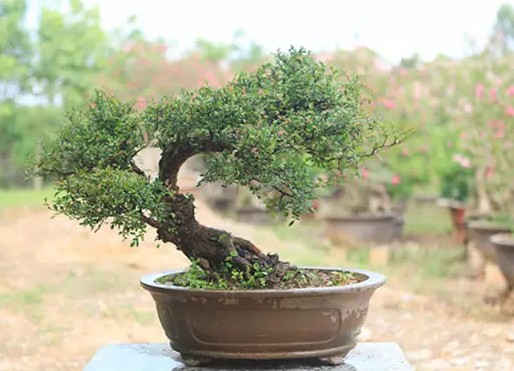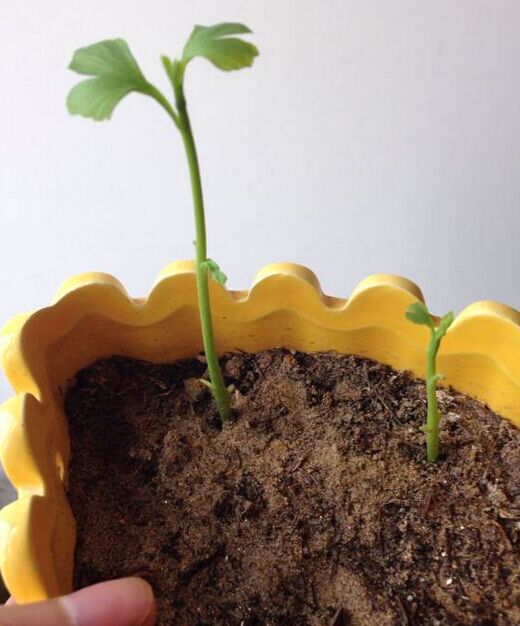The method of making jungle bonsai
Jungle bonsai mainly reflects the comprehensive image of the beauty of trees. Although the choice of plant form is not as strict as other bonsai. However, the image of group beauty is reflected through the combination of individuals. Therefore, as a jungle bonsai, every tree should be able to show its individual beauty in a unified composition. Therefore, a single plant should also have special value in posture, color and ornamental. Moreover, according to the basic principle of unity and change, there must be similarities and differences between plants. To achieve a clear distinction between primary and secondary, the main scene is prominent, do not plant equidistant, there should be sparse and dense.

1. Planting trees
Before planting, cover the drainage holes at the bottom of the basin with plastic mesh or thin tiles, then spread a layer of soil, and put the trees according to the position determined during the trial, so that the roots can be stretched and distributed as far as possible. Then cultivate the soil and fill the trees to plant stably, and the soil surface can make some ups and downs, which is more natural.
2. Select trees
In the jungle bonsai, every tree is not required to be beautiful, but in a unified posture and natural style. The appreciation of some trees is not beautiful, and even has obvious defects, but after the combination can enhance their strengths and avoid weaknesses, there is an excellent ornamental effect. The selected trees had better be potted plants. such trees have good roots and are easy to survive when implanted into new ornamental pots. Trees should be large and small, tall and short, thick and thin, in order to design an ideal composition.
3. Selection of basin
Jungle bonsai often choose shallow rectangular basin, waist round basin, oval basin and so on, which help to reflect the vastness and profoundness of the landscape. There are generally drainage holes at the bottom of the basin, but very shallow basins can be an exception. The texture and color of the basin should be in harmony with bonsai tree species. The commonly used basins are stone basin, glazed pottery basin, purple sand basin and so on.
4. Take off the basin and pick the soil
Arrange the root system to remove the selected trees from the basin and carefully remove some of the soil with bamboo sticks so that they can enter the new ornamental basin. The root system that hinders the combination and planting can be properly trimmed without affecting the survival, while the brown wire or metal wire that hinders the planting but is not suitable for cutting can be tied and bent and then implanted into the basin.
5. Tree layout
The layout of trees is the key to the success or failure of jungle bonsai. By observing, deliberating and adjusting the position of the trees in the basin, we try to make the layout of a number of trees in the basin, so that there are primary and secondary, sparse and dense, high and low; trees compete with each other, take care of each other, and form a beautiful layout.
6. Pruning branches and leaves
After the layout is determined, each tree should be pruned one by one according to the requirements of composition. Cut off the branches that affect the overall effect, overlapping branches, too dense branches and too many leaves, etc., delete and simplify, in order to achieve a clear rhythm of the artistic effect.
7. Place the furnishings
In order to enrich the artistic conception and highlight the theme, it is sometimes necessary to put characters, animals, houses and other furnishings in bonsai. The size of the accessories should be in proportion and the position should be appropriate.
8. Embellishment
Mountain and stone jungle bonsai are often dotted with rocks to increase the wild interest of the mountains and forests, and at the same time make the picture more vivid. The selected stone species and shape should be consistent with the charm of the trees in the basin, making the artistic conception more profound. After putting stones on the cloth, you also need to cover the soil with moss. Green moss, like green grass, can add vitality to the scenery. The transition between trees and stones with moss is more natural and harmonious.
9. Watering
The newly finished bonsai should be sprayed with a fine spray pot with a tree basin until the potted soil is completely soaked. By doing so, the roots of the newly planted trees are closely combined with the soil to help them survive, and the whole bonsai is also cleaned.
Time: 2019-05-26 Click:
- Prev

The method of making bonsai of hammer elm
The original tall and big tree species into bonsai display at home, can add a stable and generous living, but also can increase a lot of family style, nut elm bonsai of course also has this effect, let's take a look at how to make a pot of nut elm pile bonsai. Selection of pots: glazed pottery pots are generally suitable for hammer elm pile scenes.
- Next

The method of making bonsai of Ginkgo biloba seedlings
Ginkgo biloba is a deciduous tree of Ginkgo biloba family. Ginkgo biloba, which appeared hundreds of millions of years ago, is the oldest relict of gymnosperms left over from the Quaternary glacial movement. Ginkgo biloba is rare and scattered in the world, and hundreds of years old trees are rare. All other plants of the same class have become extinct.
Related
- Fuxing push coffee new agricultural production and marketing class: lack of small-scale processing plants
- Jujube rice field leisure farm deep ploughing Yilan for five years to create a space for organic food and play
- Nongyu Farm-A trial of organic papaya for brave women with advanced technology
- Four points for attention in the prevention and control of diseases and insect pests of edible fungi
- How to add nutrient solution to Edible Fungi
- Is there any good way to control edible fungus mites?
- Open Inoculation Technology of Edible Fungi
- Is there any clever way to use fertilizer for edible fungus in winter?
- What agents are used to kill the pathogens of edible fungi in the mushroom shed?
- Rapid drying of Edible Fungi

